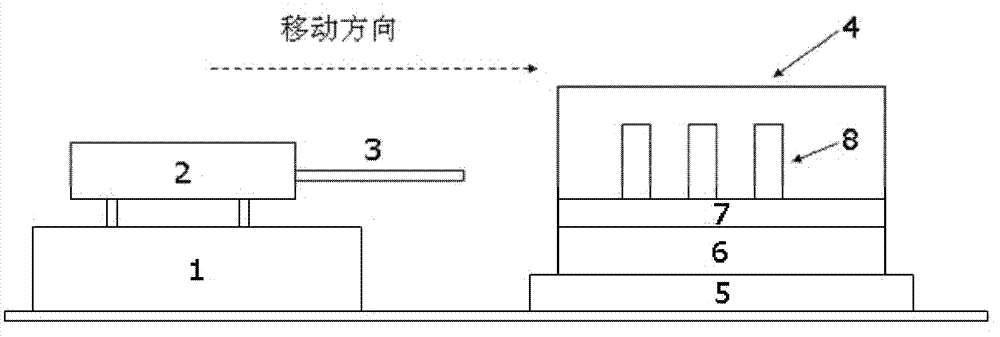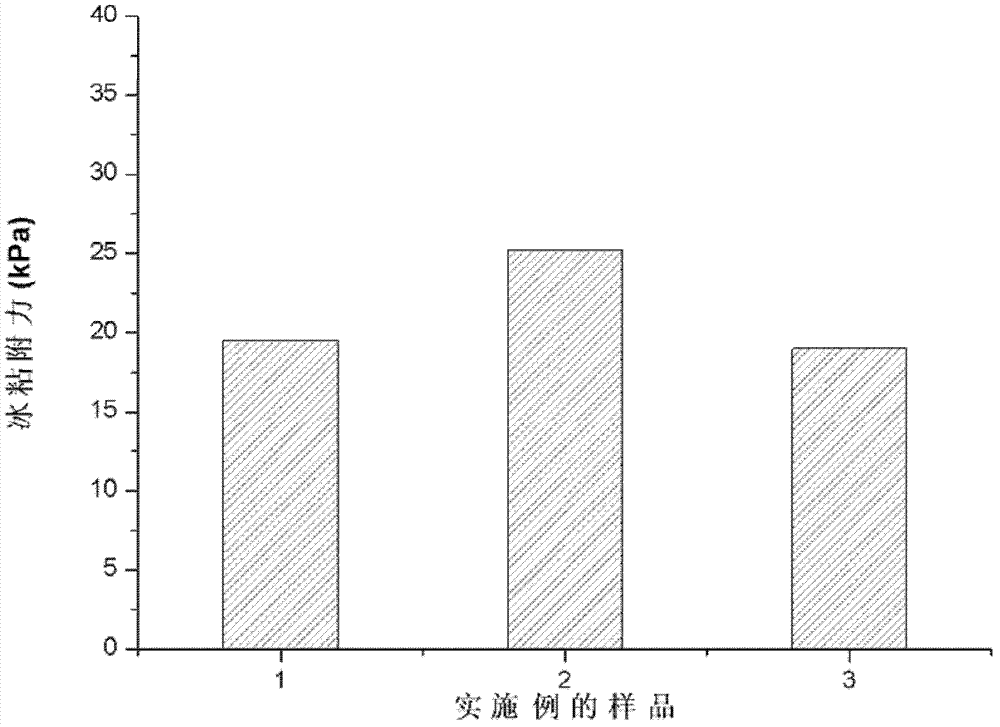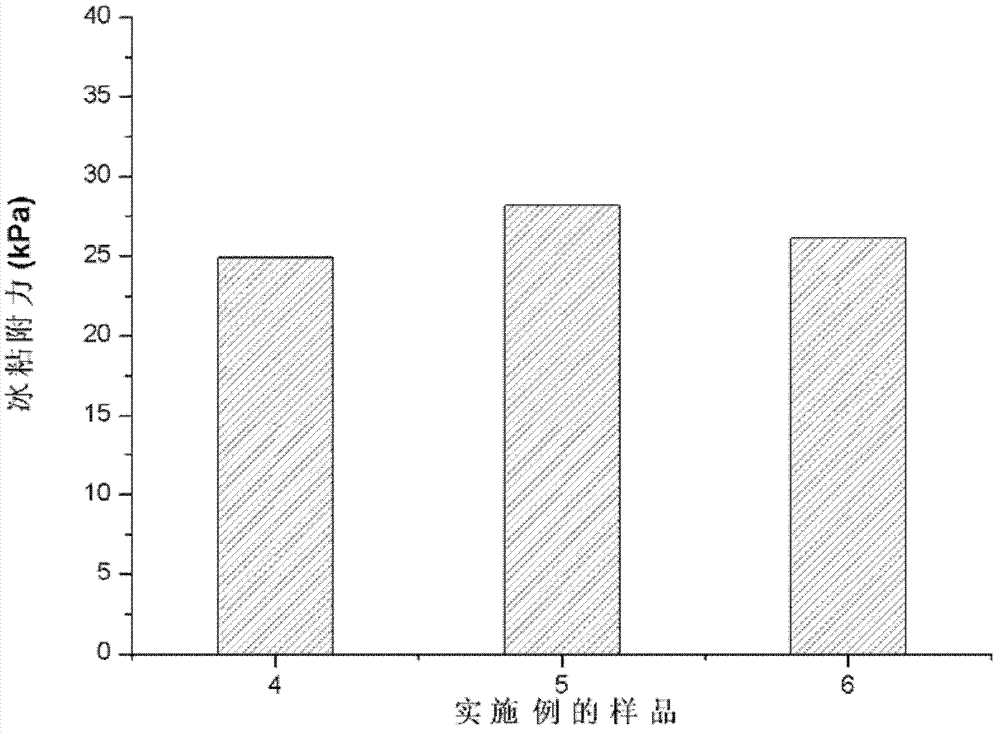Icing-proof coating with low ice adhesion, and preparation method and application thereof
An anti-icing and adhesion technology, used in coatings, devices for coating liquids on surfaces, etc., can solve the problems of large labor and material resources, limited temperature range, reduced anti-icing and frost resistance, etc., to improve mechanical performance and resistance. Abrasiveness, good mechanical properties, and the effect of prolonging service life
- Summary
- Abstract
- Description
- Claims
- Application Information
AI Technical Summary
Problems solved by technology
Method used
Image
Examples
Embodiment 1
[0041] (1), preparation of cross-linked hydrophilic polyelectrolyte
[0042] The mass fraction is 30% acrylic acid, 5% divinylbenzene, 5% vinyl trimethoxysilane, 0.1% phenyl bis(2,4,6-tri Toluyl) phosphine oxide was dissolved in the remaining amount of methanol, after stirring evenly, at 10mw / cm 2 Under light conditions (wavelength: 365nm), free radical polymerization was initiated by phenylbis(2,4,6-trimethylbenzoyl)phosphine oxide for 15 minutes to obtain cross-linked polyacrylic acid.
[0043] (2), preparation of anti-icing coating
[0044] The anti-icing coating is obtained by mixing 30% of diatomite and 70% of the total mass of the anti-icing coating with the cross-linked polyacrylic acid prepared in step (1) and ball milling for 48 hours.
[0045] (3) Application of anti-icing coating
[0046] The anti-icing coating prepared in step (2) is directly coated on the surface of the aluminum sheet and dried to form a film. After being dried and formed into a film, it is pla...
Embodiment 2
[0049] (1), preparation of cross-linked hydrophilic polyelectrolyte
[0050] The mass fraction is 40% vinylbenzene sulfonic acid, the mass fraction is 5% diphenylmethane diisocyanate, the mass fraction is 5% vinyltriethoxysilane, and the mass fraction is 0.2% 2-hydroxyl-2 -Methyl-1-phenylacetone was dissolved in the remaining amount of ethanol, after stirring evenly, at 20mw / cm 2 Under light conditions (wavelength: 365 nm), free radical polymerization was initiated by 2-hydroxy-2-methyl-1-phenylacetone for 15 minutes to obtain cross-linked polyvinylbenzenesulfonic acid.
[0051] (2), preparation of anti-icing coating
[0052] The activated alumina that accounts for 20% of the total mass of the anti-icing coating and the cross-linked polyvinylbenzenesulfonic acid that accounts for 80% of the total mass of the anti-icing coating are mixed and ball milled for 72 hours to obtain the anti-icing coating ice paint.
[0053] (3) Application of anti-icing coating
[0054] The anti-...
Embodiment 3
[0057] (1), preparation of cross-linked hydrophilic polyelectrolyte
[0058] The mass fraction is 60% allylsulfonic acid, the mass fraction is 5% N,N-methylenebisacrylamide, the mass fraction is 5% allyltrimethoxysilane, and the mass fraction is 0.5% 1-Hydroxycyclohexyl phenyl ketone was dissolved in the remaining amount of isopropanol, after stirring evenly, at 30mw / cm 2 Under light conditions (wavelength: 365nm), free radical polymerization was initiated by 1-hydroxycyclohexyl phenyl ketone for 15 minutes to obtain cross-linked polyallyl sulfonic acid.
[0059] (2), preparation of anti-icing coating
[0060] The clay that accounts for 10% of the total mass of the anti-icing coating and the cross-linked polyallyl sulfonic acid that accounts for 90% of the total mass of the anti-icing coating are mixed and ball milled for 120 hours to obtain the anti-icing coating .
[0061] (3) Application of anti-icing coating
[0062] The anti-icing coating prepared in step (2) is direc...
PUM
 Login to View More
Login to View More Abstract
Description
Claims
Application Information
 Login to View More
Login to View More - R&D
- Intellectual Property
- Life Sciences
- Materials
- Tech Scout
- Unparalleled Data Quality
- Higher Quality Content
- 60% Fewer Hallucinations
Browse by: Latest US Patents, China's latest patents, Technical Efficacy Thesaurus, Application Domain, Technology Topic, Popular Technical Reports.
© 2025 PatSnap. All rights reserved.Legal|Privacy policy|Modern Slavery Act Transparency Statement|Sitemap|About US| Contact US: help@patsnap.com



